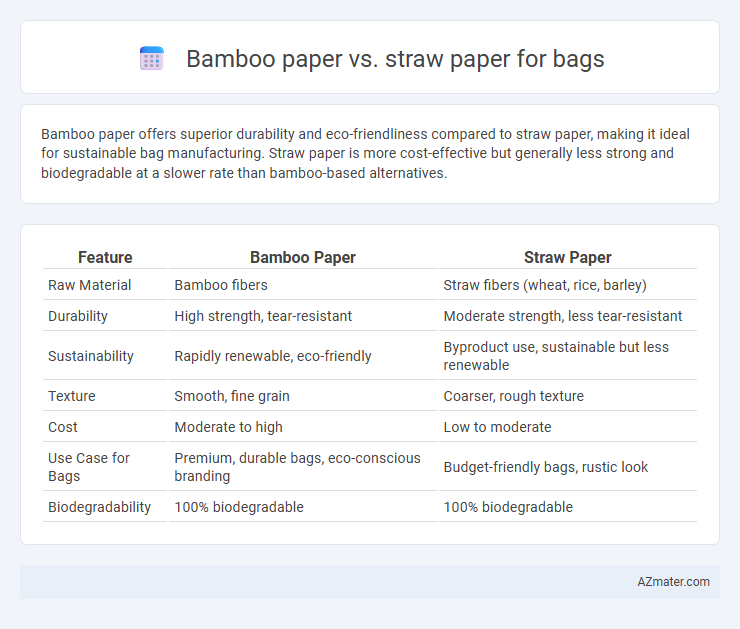Bamboo paper offers superior durability and eco-friendliness compared to straw paper, making it ideal for sustainable bag manufacturing. Straw paper is more cost-effective but generally less strong and biodegradable at a slower rate than bamboo-based alternatives.
Table of Comparison
| Feature | Bamboo Paper | Straw Paper |
|---|---|---|
| Raw Material | Bamboo fibers | Straw fibers (wheat, rice, barley) |
| Durability | High strength, tear-resistant | Moderate strength, less tear-resistant |
| Sustainability | Rapidly renewable, eco-friendly | Byproduct use, sustainable but less renewable |
| Texture | Smooth, fine grain | Coarser, rough texture |
| Cost | Moderate to high | Low to moderate |
| Use Case for Bags | Premium, durable bags, eco-conscious branding | Budget-friendly bags, rustic look |
| Biodegradability | 100% biodegradable | 100% biodegradable |
Introduction to Sustainable Paper Alternatives
Bamboo paper and straw paper are emerging sustainable alternatives to traditional wood-based paper, widely used in eco-friendly bags due to their renewable, fast-growing raw materials. Bamboo paper offers exceptional strength and softness, derived from bamboo fibers known for their rapid growth and low environmental impact. Straw paper utilizes agricultural byproducts like wheat or rice straw, reducing waste and promoting circular economy benefits while maintaining durability and printability for bag production.
What is Bamboo Paper?
Bamboo paper is a sustainable, eco-friendly material made from the pulp of bamboo fibers, known for its durability, softness, and biodegradable properties. It offers higher tensile strength and natural antibacterial qualities compared to traditional paper, making it ideal for environmentally conscious bag production. Bamboo paper's fast-growing source and minimal chemical processing result in a reduced carbon footprint, positioning it as a superior alternative to straw paper in sustainable packaging solutions.
What is Straw Paper?
Straw paper, made from agricultural crop residues such as wheat, rice, and barley stalks, offers an eco-friendly alternative to traditional wood pulp paper. It utilizes fast-growing, renewable raw materials, reducing deforestation and lowering carbon footprints in bag production. Compared to bamboo paper, straw paper provides comparable durability and texture while capitalizing on abundant, underutilized waste resources.
Environmental Impact: Bamboo vs Straw Paper
Bamboo paper for bags offers a lower environmental footprint due to bamboo's rapid growth rate and minimal need for pesticides, making it a highly sustainable resource. Straw paper, derived from agricultural residues like wheat and rice straw, reduces waste by repurposing byproducts but may involve more energy-intensive processing compared to bamboo. Lifecycle assessments reveal bamboo paper generally emits less CO2 and uses less water, positioning it as a more eco-friendly option in sustainable packaging.
Manufacturing Process Comparison
Bamboo paper manufacturing involves processing bamboo fibers through mechanical and chemical treatments, resulting in strong, sustainable material with natural antibacterial properties. Straw paper production typically uses wheat or rice straw treated with pulping chemicals, offering cost-effective and eco-friendly options but with lower tensile strength. Both processes emphasize biodegradability, yet bamboo paper requires less bleaching, reducing chemical usage and environmental impact compared to straw paper.
Strength and Durability in Bag Applications
Bamboo paper offers superior tensile strength and tear resistance compared to straw paper, making it more suitable for heavy-duty bag applications. Its natural fibers contribute to enhanced durability and resistance to wear and moisture, ensuring longer-lasting performance. Straw paper, while eco-friendly, tends to be less robust and is more prone to damage under stress, limiting its use in high-strength bag requirements.
Aesthetics and Texture Differences
Bamboo paper offers a smooth, fine texture with a consistent grain, lending bags a sleek and sophisticated appearance that highlights natural fiber elegance. Straw paper, characterized by its coarser, uneven surface and visible fibrous strands, provides a rustic, organic aesthetic enhancing the tactile richness and visual uniqueness of bags. The tactile contrast makes bamboo paper ideal for minimalist, modern designs, while straw paper suits eco-friendly, artisanal styles emphasizing texture and natural imperfection.
Cost Analysis: Bamboo Paper vs Straw Paper
Bamboo paper generally incurs higher production costs due to its complex processing and longer growth cycles compared to straw paper, which benefits from abundant agricultural waste materials. Straw paper offers a cost-effective alternative with lower raw material expenses and faster manufacturing times, making it attractive for bag production in price-sensitive markets. However, bamboo paper provides superior durability and eco-friendliness, which can justify its premium pricing despite the increased initial investment.
Consumer Perception and Market Trends
Consumers increasingly favor bamboo paper bags for their sustainability, durability, and eco-friendly reputation, which align with current market trends emphasizing environmental responsibility. Straw paper bags appeal to niche markets seeking biodegradable options with a rustic aesthetic, yet they are often perceived as less durable compared to bamboo alternatives. Market data indicates a growing preference for bamboo paper bags driven by regulatory shifts and consumer demand for high-quality, sustainable packaging solutions.
Conclusion: Choosing the Right Paper for Bags
Bamboo paper offers superior strength, sustainability, and a smoother texture, making it ideal for durable, eco-friendly bags requiring a premium finish. Straw paper provides a cost-effective, biodegradable option with a rustic appearance, suitable for lightweight bags and budget-conscious brands aiming for a natural aesthetic. Selecting the right paper depends on balancing durability needs, environmental impact, and visual appeal to enhance brand identity and customer experience.

Infographic: Bamboo paper vs Straw paper for Bag
 azmater.com
azmater.com